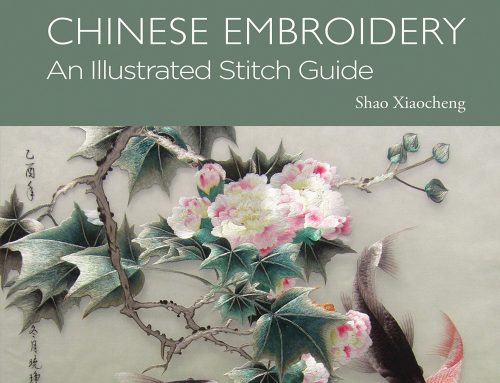Question: What is the origin of Chinese embroidery?
Answer: The Long History of Chinese Embroidery Culture.
Embroidery is a traditional Chinese folk craft with a long history. Using silk as the primary material, it involves the use of needles and various colored threads to create patterns on fabric (base material) by repeatedly threading the needle. This ancient craft, with its vibrant and dazzling beauty, captivates people’s imaginations, evoking a lingering sense of wonder and nostalgia.
A Legend of Nimble Hands: The Story of Women’s Needlework
There is a widely circulated legend about the origin of embroidery: Zhongyong, also known as Yu Zhong, was a man from the late Shang Dynasty in Zhou (modern-day Qishan County, Baoji, Shaanxi). He had two brothers, Taibo and Jili. To fulfill their father, King Tai of Zhou’s wish, Zhongyong and Taibo left the Central Plains, embarking on a long journey to the southern region (modern-day Jiangnan). They adopted the local customs of cutting their hair and tattooing their bodies. Zhongyong assisted Taibo in establishing the Gouwu State. After Taibo passed away, Zhongyong became the ruler. He couldn’t bear seeing people tattooing their bodies, so he convened a meeting to discuss the matter. His granddaughter, Xiaohong, was sewing in another room and accidentally pricked her finger, causing blood to stain the fabric like flowers. Inspired by this, Xiaohong used five-colored silk threads to embroider patterns on the cloth. She presented the embroidered garment to her grandfather, who found it more beautiful than tattoos. He then advocated for people to wear embroidered clothing instead of tattooing. In memory of Xiaohong’s invention, this craft was called “women’s needlework.”
Archaeological Evidence
Though the legend is fascinating, there is no concrete evidence to pinpoint the exact origin of embroidery. However, the discovery of an 18,000-year-old bone needle at the Zhoukoudian site in Beijing suggests that humans had mastered weaving and sewing techniques in prehistoric times. This provided the material foundation for the birth of embroidery.
Literary Evidence
In the ancient text “The Book of Yu – Yi and Ji,” there are descriptions of the specific patterns on the emperor’s garments: “I wish to see the symbols of ancient people: the sun, moon, stars, mountains, dragons, and beautiful insects as drawings; religious vessels, algae, fire, rice grains, axes, and symbols of loyalty and respect embroidered with five colors, displayed on five-colored garments.” These twelve symbolic patterns represented various elements of nature and were embroidered on clothes, reflecting ancient nature worship.
The Transition from Tattoos to Embroidery Driven by Weaving Technology
Considering legends, literary records, and recent archaeological findings, it is plausible that early embroidery originated from the practice of body tattooing among ancient people. As weaving techniques matured and became widespread, these patterns were gradually transferred to daily clothing, symbolizing status and identity while serving as vivid decorations. Over time, embroidery evolved into both a practical and artistic expression, enduring to this day.
From the simplest forms of sewing and embroidery to the diverse styles seen today, embroidery has never ceased to beautify and enhance life on the Chinese landscape over thousands of years, leaving behind countless remarkable works and techniques, still vibrant and dynamic.

问:中国刺绣的起源是什么?
答:中华刺绣文化源远流长
刺绣是中国历史悠久的民间工艺,以蚕丝为主要材料,通过针和各种彩色丝线在织物(底料)上反复穿针引线而绣成图案。这种古老技艺的绚丽多姿、霞光般的华美,牵引着人们的遐想,令人回味沉醉。
洪荒之力化作绕指轻柔——女红的传说
关于刺绣的起源,有一个流传甚广的传说:仲雍又称虞仲,商末周国人(今陕西宝鸡岐山县一带)。他有兄弟三人,哥哥泰伯和弟弟季历。为了成全父亲周太王的愿望,仲雍随兄泰伯从中原走出,来到今日江南一带,并和当地居民一样断发文身。仲雍助兄泰伯建句吴国,泰伯去世后,仲雍接任句吴国君主。他不忍后人还在身上刺绘图纹,于是召集众人商议此事。正在房里缝衣服的孙女小红听到后,被针刺破手,血洇在衣服上,像花朵一样。这触动了小红的灵感,她用五色彩丝在衣服上绣出图案。几天后,她把绣好的衣服捧给祖父看,仲雍发现比纹在身上的图样好看多了,便提倡大家改穿绣着图纹的衣服,不再文身。为了纪念小红的发明,这种手工艺被称为“女红”。
考古出土佐证
传说虽然动人,但刺绣的确切起源尚无确凿证据。然而,北京周口店“山顶洞人”遗址中出土的一万八千年前的骨针,长8.2厘米,直径0.33厘米,有穿针孔,说明早在史前时期,人类已经掌握了纺织和缝纫技术,这为刺绣的诞生提供了物质基础。
文献记载佐证
《虞书·益稷》中记载了天子服饰上十二章的具体纹样:“予欲观古人之象,日、月、星辰、山、龙、华虫作绘;宗彝、藻、火、米粉、黼、黻絺绣,以五彩彰施于五色作服。”这十二章纹样包括日、月、星辰、山、龙、华虫等六者画以作绘,施绣于衣;宗彝(虎与长尾猴)、藻(水草)、粉米(白米)、火、黼(黑白交织出的斧形)、黻(黑与青交织成的两“弓”相背的符号)等六者画以作绘,施绣于裳。它们象征着天地万物的形态和色彩,是古代自然崇拜的一种集中体现。
织作技术成熟推动纹身转化为刺绣
早期刺绣可能源于上古先民断发文身的习俗,随着纺织工艺的成熟和普及,这些图案逐渐转移到日常服饰上,成为身份和地位的象征,并具有鲜明的装饰作用。随着时间的推移,刺绣逐渐演化为生活日用及艺术欣赏两部分,延绵至今。
从最开始的简单缝纫刺绣,到如今各种流派的异彩纷呈,刺绣在中华大地发源后,几千年来从未停止过美化并服务生活的发展历程,留下了无数精彩的作品和技艺。





